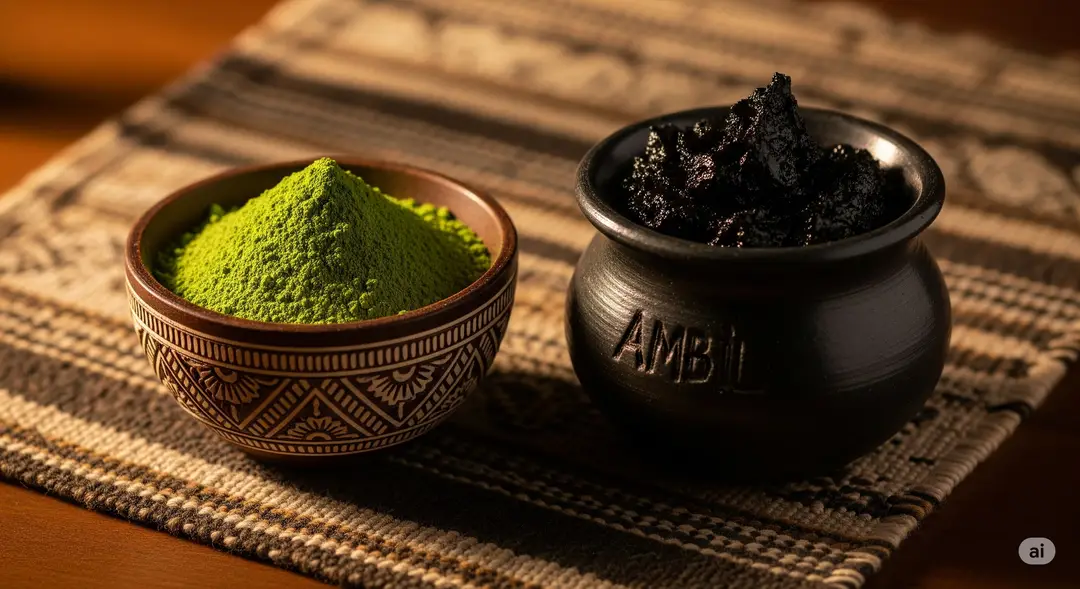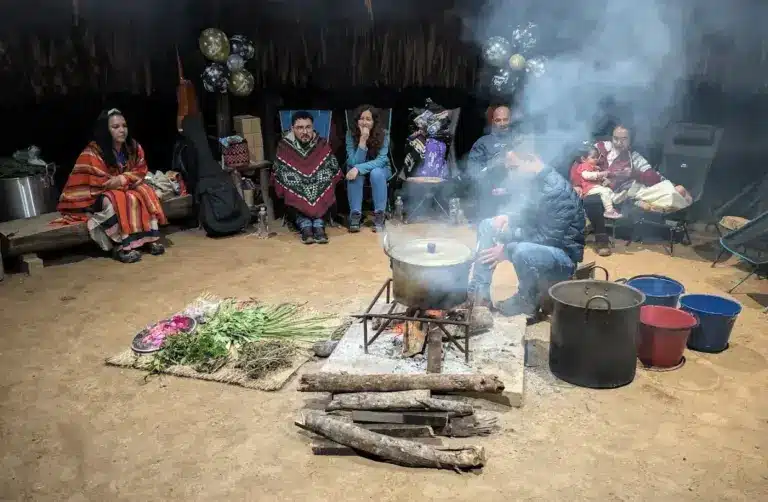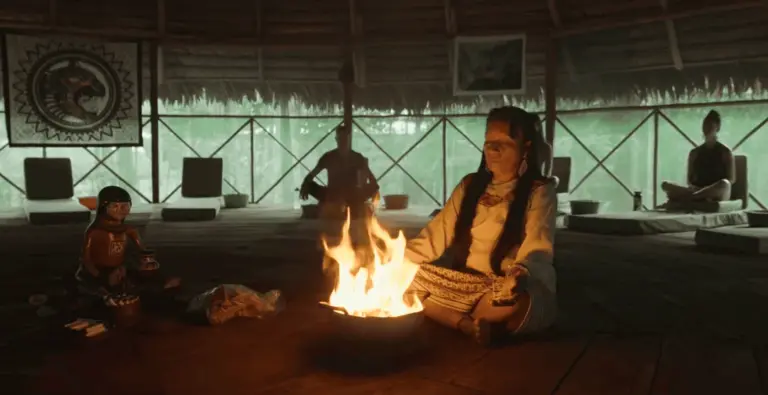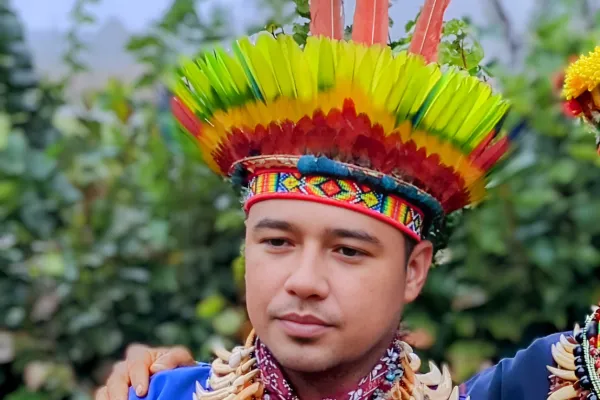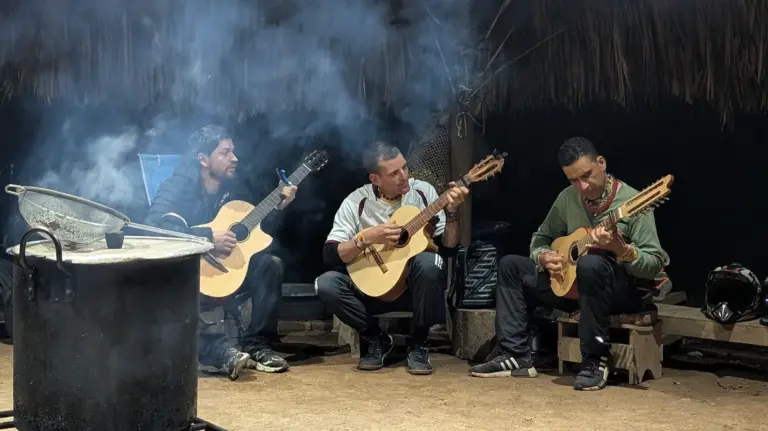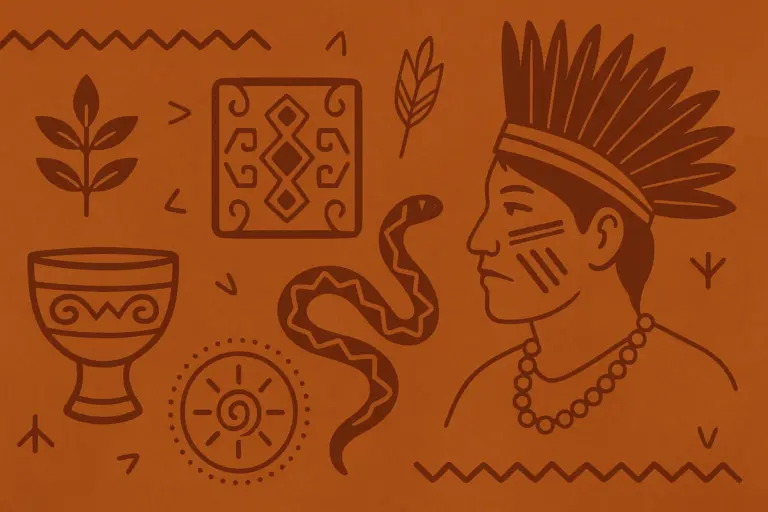Mambe and Ambil: The Word & Power of Sacred Colombian Medicine
In this guide, we offer an in-depth exploration of Mambe (sacred coca) and Ambil (sacred tobacco), two of the most important plant medicines in Amazonian Indigenous wisdom. You will learn what they are, how they are prepared, their effects, cultural significance, and their complex legal status in the modern world. At Fundación Camino al Sol, we believe that understanding these foundational elements is crucial for anyone seeking an authentic connection with the sacred plant traditions of Colombia. This guide provides a comprehensive look at their origins, preparation, cultural significance, and their place in the modern world.
The Sacred Elements: Origins and Preparation
At Fundación Camino al Sol, our work with sacred plant medicines extends beyond yagé (ayahuasca) to encompass the full trinity of Amazonian healing: yagé, coca, and tobacco. We begin by exploring two of the most essential, yet often misunderstood, medicines in our tradition—Mambe and Ambil. Understanding these sacred preparations deepens our appreciation for the interconnected wisdom of indigenous plant medicine and enhances our authentic practice here in Colombia.
Mambe – The Sacred Coca Powder (Ypadú)
Deep within the Amazon rainforest, where our elders prepare our sacred medicines, two plant preparations form the cornerstone of spiritual and social life for numerous indigenous peoples.
Mambe, known as jíbie to the Muruy-Muyna people or more broadly as ypadú, is a fine, vibrant green powder that our Colombian elders consider sacred “food” (alimento). Unlike Western conceptualizations of “drugs,” indigenous communities understand Mambe as sustenance that provides the spiritual and physical endurance required for the long, nocturnal dialogues and ceremonies central to our work.
The primary ingredient is the leaf of the coca plant—Mama Coca—revered throughout the Andes and Amazon. The species used for Mambe typically come from Erythroxylum coca and Erythroxylum novogranatense. However, coca leaves alone do not make Mambe. The second critical component is an alkalizing agent, traditionally ash from the Yarumo tree (Cecropia spp.). This ash serves a vital chemical function: it raises the pH in the mouth, facilitating superior absorption of coca alkaloids through the mucous membranes—a sophisticated understanding of plant chemistry perfected over millennia.
The Sacred Preparation of Mambe
The creation of Mambe mirrors the careful intention we bring to preparing all our sacred medicines. The process begins with respectful harvesting of selected coca leaves, which are then toasted in large earthenware pots. This gentle heating dries the leaves and activates their properties. Following toasting, leaves are transferred to large wooden mortars called pilones, where they are crushed and pulverized. This labor-intensive task requires the preparer to maintain focused, positive intention—their thoughts are believed to infuse the medicine. Finally, the mixture is meticulously sieved, yielding an ultra-fine, vivid green powder.
Ambil – The Sacred Tobacco Paste
If Mambe is the “food” that sustains, Ambil is the “power” that guides. This thick, black, intensely bitter paste made from tobacco is often called the “blood of tobacco.” It is the indispensable complement to Mambe, providing grounding and focusing properties essential for navigating the spiritual territory these medicines open.
The botanical source of Ambil is Nicotiana rustica, known in our Amazon as Mapacho. This is the same potent tobacco species that features in our traditional ceremonies and is much more powerful than commercial tobacco, containing up to 20 times more nicotine along with other psychoactive alkaloids. This potency is precisely why our elders regard it as a powerful spiritual tool, not a recreational substance.
The Alchemical Preparation of Ambil
The preparation of Ambil is an alchemical process embodying patience and reverence. Fresh tobacco leaves are placed in pots with water and cooked slowly over wood fires for up to three days. This requires constant stirring as the mixture reduces to a thick paste. Alkalized vegetal salts from burnt palm trunk ash are added, providing important chemical functions and mineral content.
A Critical Distinction: Amazonian vs. Indian “Ambil”
It’s crucial to understand that two entirely different preparations share the name “Ambil.” The first is our Amazonian Ambil: the sacred tobacco paste used ceremonially in Colombia alongside Mambe. The second is Indian Ambil: a nutritious porridge made from finger millet flour, popular in Maharashtra and Goa. This healthy food has no psychoactive properties. Understanding this distinction helps those preparing for authentic experiences with sacred plant medicines avoid confusion and approach these traditions with respect.
The Fusion of Indigenous Science and Spirit
The meticulous creation of both Mambe and Ambil demonstrates the profound indigenous knowledge that guides all our work. The insight that alkaline agents increase bioavailability of coca alkaloids represents sophisticated chemical understanding. Yet this material science is inseparable from a spiritual framework. The requirement that preparers maintain focused, prayerful states reveals an understanding that the energetic quality of medicine is as important as its chemical composition. This fusion of chemistry and consciousness guides our commitment to authentic preparation methods.
The Heart of the Maloca: Cultural and Spiritual Significance
To understand Mambe and Ambil fully, we must enter the maloca—the traditional longhouse that serves as the center of Amazonian indigenous life. Here, these plants are not consumed as mere substances but engaged as living spirits that weave together the community fabric.

The Divine Synergy: Word and Power in Union
In traditional ceremonial contexts, Mambe and Ambil are almost never used in isolation. They represent complementary halves of a fundamental duality: Mambe is the “Word” (palabra), the vehicle for communication, while Ambil is the “Power” or “Thought” (pensamiento), the force that grounds and gives weight to the word. Some traditions hold that coca leaves are shaped like human tongues while tobacco seeds resemble hearts, together signifying palabra con corazón—”word with heart.” This principle of heart-centered communication guides our ceremony facilitators.
Mindful Consumption: How Mambe and Ambil are Used
The consumption method reflects deep mindfulness. Mambe is not chewed aggressively but placed in the cheek where it slowly dissolves. Ambil is taken in small amounts on the pinky finger—symbolically, the finger of humility—and applied to the teeth and gums for gradual absorption. This slow administration fosters a calm, centered awareness perfectly suited for ceremonial purposes.
The Effects and Benefits of Mambe and Ambil
While the experience is unique to each individual, Mambe and Ambil are known for producing a range of subtle but profound effects. Unlike intense visionary psychedelics, their influence is grounding, clarifying, and centering. Users often report the following benefits:
- Enhanced Mental Clarity: A primary effect is a state of calm, focused thought. It helps quiet mental chatter, allowing for deeper concentration and more articulate communication.
- Gentle Physical Endurance: Mambe is a mild stimulant that wards off fatigue, hunger, and thirst, which is essential for long ceremonial nights. The effect is one of sustained energy without the jitteriness of caffeine.
- Spiritual Grounding: Ambil provides a powerful grounding quality. It centers the user, offering a sense of stability and connection to the earth, which balances the cerebral effects of Mambe.
- Heart-Opening Communication: Together, the medicines are said to foster “word with heart,” encouraging open, honest, and compassionate dialogue within the group.
The Círculo de la Palabra: Weaving Community with Medicine
The primary setting for Mambe and Ambil use is the círculo de la palabra (circle of the word). The fundamental purpose is to “sharpen thought and cleanse the spirit to make man harmonize with man and men with Nature and the cosmos”—an intention that resonates deeply with our mission. This ritual functions as an integrated form of “bio-social technology,” where pharmacology is harnessed to produce a desired social outcome. It serves multiple functions: governance, education, social healing, and transmission of sacred knowledge. A key protocol is that anyone who introduces a problem must also offer a solution, ensuring dialogue remains constructive. The ultimate goal is achieving palabra perfecta—the “perfect word” of harmonious, truthful, heart-centered communication.
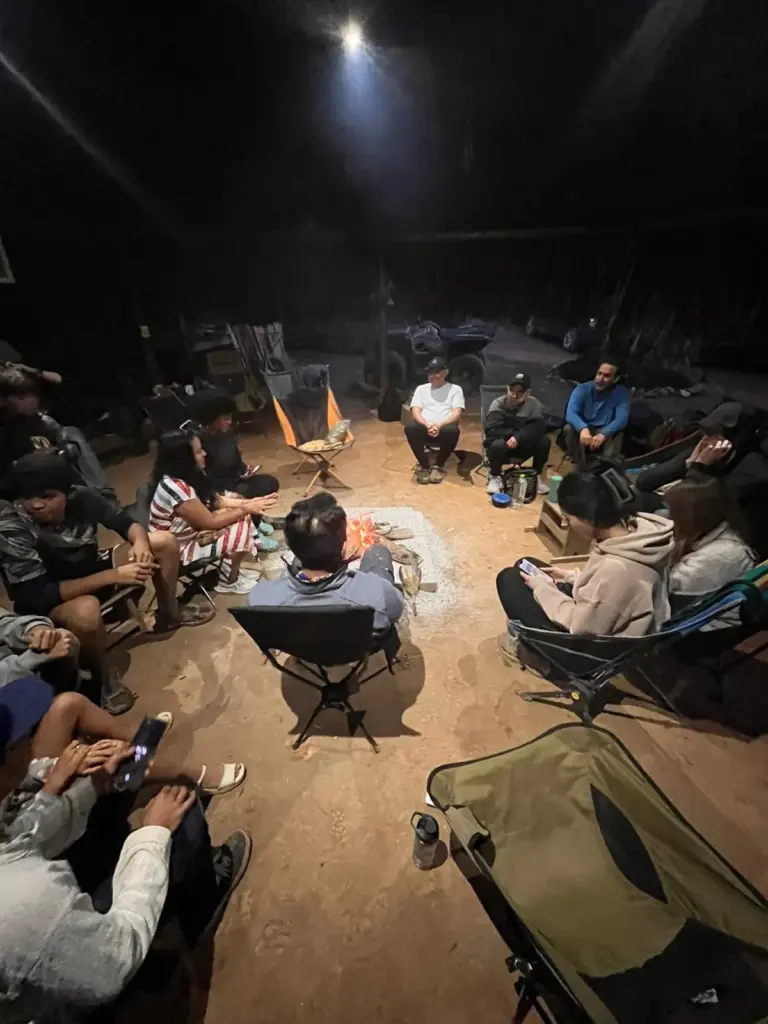
How Mambe and Ambil Integrate with Yagé Traditions
Understanding Mambe and Ambil enhances our yagé work by revealing the broader framework of Amazonian healing. While yagé ceremonies often involve intense, visionary experiences leading to a silent, inward contemplation, Mambe circles are gentle and meditative, fostering grounded, lucid states that facilitate collective dialogue. Our elders understand these medicines work synergistically. At Fundación Camino al Sol, we are dedicated to sharing the love and messages of all Sacred Plant Medicines—Yagé, Coca, and Tobacco—following the holistic traditions set forth by our Colombian Elders.
Cosmology and the Spirit of the Plants
The use of these medicines is deeply embedded in the shamanic cosmovision that guides our practice—the understanding that the visible world is animated by deeper spirit forces. Plants are not inert molecular collections but intelligent, living beings. This understanding informs every aspect of our work, from how our elders prepare our yagé to how we create sacred space. The power of these medicines lies not just in their chemistry but in the ancient, reciprocal relationship between humanity and the living world.
Sacred Plants in the Modern World: Science, Law, and Authenticity
We navigate daily the complex realities of bringing authentic indigenous traditions into the modern world. Understanding the scientific, legal, and cultural landscape surrounding these sacred medicines is essential to our mission of authentic practice and education.
Mama Coca vs. Cocaine: A Profound Pharmacological Distinction
One of the greatest challenges is correcting the fallacy of equating the sacred coca leaf with refined cocaine hydrochloride. This is like “saying potatoes are only vodka.”
- Whole Coca Leaf (Mama Coca): A complex nutritional and medicinal plant rich in minerals, vitamins, and protein. It contains over 14 different alkaloids, with cocaine comprising only $0.1\%$ to $0.9\%$ of the leaf’s total weight. Its effect is a gentle stimulation, enhancing focus and endurance. Studies of traditional users show modest blood cocaine levels (around 98 ng/mL) and find no evidence of addiction or withdrawal.
- Cocaine Hydrochloride: A single alkaloid chemically extracted using toxic solvents. A single dose can result in blood plasma concentrations of 200,000 to 400,000 ng/mL—thousands of times higher than traditional use. It is a potent, dangerous stimulant with a high potential for addiction, which studies show affects approximately 17% of users.
Sacred Tobacco vs. Commercial Tobacco: A Fundamental Difference
A similar distinction exists between the sacred tobacco (Nicotiana rustica) used in our traditions and commercial tobacco products.
- Sacred Tobacco (Mapacho): A whole-plant medicine prepared via pure, slow decoction. It contains up to 20 times more nicotine and other compounds like harmala alkaloids. Its potency acts as a built-in safety mechanism against recreational abuse and it is not associated with addiction in its sacred context.
- Commercial Tobacco: An industrial product treated with thousands of chemical additives designed to enhance addictiveness. The route of administration (smoking) is directly linked to carcinogenic tars and is the leading cause of preventable death and disease worldwide.
Navigating the Complex Legal Landscape
The 1961 UN Single Convention on Narcotic Drugs incorrectly classified coca leaf in Schedule I alongside heroin, a decision based on flawed reports, not science. This classification has been controversial for decades, and Andean nations are now leading a movement to correct this historical injustice through a critical review by the World Health Organization (WHO). A peculiar hypocrisy in US law is the “Coca-Cola Exception,” where the Stepan Company legally imports coca leaves to extract a flavoring agent, while all other imports remain illegal.
Here in Colombia, our constitution protects traditional coca use while national laws restrict cultivation. We operate within this complex legal landscape, always ensuring our practices align with Colombian law while honoring indigenous traditions. For international participants, it’s important to know that coca leaf remains illegal in most countries, making authentic experiences like ours—conducted within a proper legal framework—incredibly valuable.
Our Approach to Modern Challenges: Avoiding Spiritual Commercialization
The growing global interest in plant medicines creates risks of commodification and cultural erosion. We have seen how traditions can be stripped of their context and sold to global markets, undermining local indigenous communities. This is why our approach at Fundación Camino al Sol prioritizes direct, sacred relationships with our Colombian elders, ensuring they remain the primary decision-makers and beneficiaries of our work. Our authentic ayahuasca retreat in Colombia is a demonstration of how to engage respectfully with these traditions, supporting indigenous communities rather than exploiting them.
Our Commitment to Reciprocity and Respect
We operate from a paradigm rooted in respect for indigenous knowledge. Our commitment to reciprocity ensures that the indigenous custodians of these medicines are honored. This means:
- Working directly with and being guided by Colombian elders.
- Ensuring traditional preparation methods are meticulously honored.
- Supporting our partner indigenous communities economically and culturally.
- Educating all participants on the proper context, history, and respect for these medicines.
- Advocating for policy changes that protect indigenous rights and sacred plants.
- Maintaining authentic practice rather than adapting traditions for commercial appeal.
Conclusion: Moving Forward with Wisdom and Humility
The story of Mambe and Ambil reveals the profound complexity of honoring ancient wisdom while navigating the challenges of the modern world. The scientific evidence presents a clear case against the chemical reductionism underpinning flawed drug laws, which have targeted indigenous heritage for decades.
As we continue our work sharing the love and messages of sacred plant medicines, we remain committed to a paradigm of respect, reciprocity, and authentic relationship with the indigenous wisdom keepers who have preserved these traditions.
For those called to work with these sacred medicines, the ultimate lesson is humility—recognizing that the “Word” and “Power” of the Amazon hold a wisdom we must approach with the deepest respect. Our role at Fundación Camino al Sol is to serve as a bridge between worlds, ensuring that this authentic indigenous wisdom can be shared safely and respectfully, always honoring the communities and elders who make this sacred work possible.

